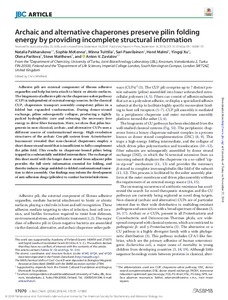Archaic and alternative chaperones preserve pilin folding energy by providing incomplete structural information
Matthews S; Zavialov AV; Xu Y; Pakharukova N; McKenna S; Paavilainen S; Tuittila M; Parilova O; Malmi H
Archaic and alternative chaperones preserve pilin folding energy by providing incomplete structural information
Matthews S
Zavialov AV
Xu Y
Pakharukova N
McKenna S
Paavilainen S
Tuittila M
Parilova O
Malmi H
AMER SOC BIOCHEMISTRY MOLECULAR BIOLOGY INC
Julkaisun pysyvä osoite on:
https://urn.fi/URN:NBN:fi-fe2021042720055
https://urn.fi/URN:NBN:fi-fe2021042720055
Tiivistelmä
Adhesive pili are external component of fibrous adhesive organelles and help bacteria attach to biotic or abiotic surfaces. The biogenesis of adhesive pili via the chaperone-usher pathway (CUP) is independent of external energy sources. In the classical CUP, chaperones transport assembly-competent pilins in a folded but expanded conformation. During donor-strand exchange, pilins subsequently collapse, producing a tightly packed hydrophobic core and releasing the necessary free energy to drive fiber formation. Here, we show that pilus biogenesis in non-classical, archaic, and alternative CUPs uses a different source of conformational energy. High-resolution structures of the archaic Csu-pili system from Acinetobacter baumannii revealed that non-classical chaperones employ a short donor strand motif that is insufficient to fully complement the pilin fold. This results in chaperone-bound pilins being trapped in a substantially unfolded intermediate. The exchange of this short motif with the longer donor strand from adjacent pilin provides the full steric information essential for folding, and thereby induces a large unfolded-to-folded conformational transition to drive assembly. Our findings may inform the development of anti-adhesion drugs (pilicides) to combat bacterial infections.
Kokoelmat
- Rinnakkaistallenteet [19207]
